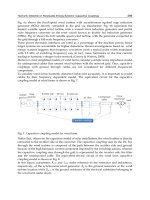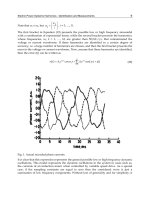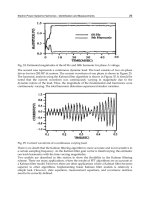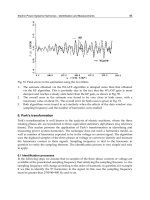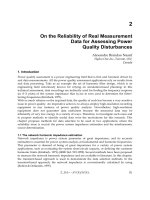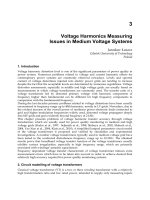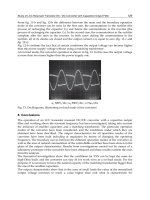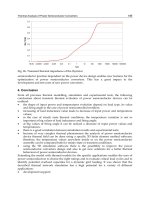Power Quality Monitoring Analysis and Enhancement Part 13 potx
Bạn đang xem bản rút gọn của tài liệu. Xem và tải ngay bản đầy đủ của tài liệu tại đây (1011.06 KB, 25 trang )
Optimal Location and Control of Flexible Three Phase Shunt FACTS
to Enhance Power Quality in Unbalanced Electrical Network
287
several decades (Mahdad.b et al., 2007). The solution techniques for the reactive power
planning problem can be classified into three categories:
•
Analytical,
•
numerical programming, heuristics,
•
and artificial intelligence based.
The choice of which method to use depends on: the problem to be solved, the complexity of
the problem, the accuracy of desired results. Once these criteria are determined, the
appropriate capacitor Allocation techniques can be chosen.
The use of fuzzy logic has received increased attention in recent years because of it‘s
usefulness in reducing the need for complex mathematical models in problem solving
(Mahdad.b, 2010).
Fuzzy logic employs linguistic terms, which deal with the causal relationship between input
and output variables. For this reason the approach makes it easier to manipulate and solve
problems.
So why using fuzzy logic in Reactive Power Planning and coordination of multiple shunt
FACTS devices?
•
Fuzzy logic is based on natural language.
•
Fuzzy logic is conceptually easy to understand.
•
Fuzzy logic is flexible.
•
Fuzzy logic can model nonlinear functions of arbitrary complexity.
•
Fuzzy logic can be blended with conventional control techniques.
Controller inputs
Fuzzifier
Inference
engine
Deffuzifier
Fuzzy
Fuzzy
Crisp
Crisp
Database Rule base
Knowledge base
Controller outputs
FLC
Fig. 5. Schematic diagram of the FLC building blocks
It is intuitive that a section in a distribution system with high losses and low voltage is ideal
for installation of facts devices, whereas a low loss section with good voltage is not. Note
that the terms, high and low are linguistic.
3.2 Membership function
A membership function use a continuous function in the range [0-1]. It is usually decided
from humain expertise and observations made and it can be either linear or non-linear. The
basic mechanism search of fuzzy logic controller is illustrated in Fig. 5.
It choice is critical for the performance of the fuzzy logic system since it determines all the
information contained in a fuzzy set. Engineers experience is an efficient tool to achieve a
Power Quality – Monitoring, Analysis and Enhancement
288
design of an optimal membership function, if the expert operator is not satisfied with the
concepetion of fuzzy logic model, he can adjust the parmaters used to the design of the
membership functions to adapt them with new database introduced to the practical power
system. Fig. 6 shows the general bloc diagram of the proposed coordinated fuzzy approach
applied to enhance the system loadability in an Unbalanced distribution power system.
Rules I
Rules II
Engineer
Experience
Rules
Coordination
VPQ ΔΔ
Power Flow
Shunt FACTS
svc
regI
V
svc
regII
V
des
reg
V
c,b,a
cal
reg
V
ε
Fig. 6. General schematic diagram of the proposed coordinated fuzzy approach
Phase a
VL L M H
()a
svc
Q
VL L M H
Phase b
VL L M H
()b
svc
Q
VL L M H
Phase c
VL L M H
()c
svc
Q
VL L M H
Where;
svc
Q
ρ
, reactive power for three phase.
The solution algorithm steps for the fuzzy control methodology are as follows:
1. Perform the initial operational three phase power flow to generate the initial
database
()
,,ΔΔ
ii i
VPQ
ρρ ρ
.
2. Identify the candidate bus using continuation load flow.
3. Identify the candidate phase for all bus
()
min
i
V
ρ
.
4. Install the specified shunt compensator to the best bus chosen, and generate the reactive
power using three phase power flow based in fuzzy expert approach:
1
=
Ste
p
a
svc
b
svc svc
c
svc
Q
Q
ρ
Optimal Location and Control of Flexible Three Phase Shunt FACTS
to Enhance Power Quality in Unbalanced Electrical Network
289
a. Combination Active and Reactive Power Rules. Fig. 7.
Fig. 7. Combination voltage, active and reactive power rules
b.
Heuristic Strategy Coordination
-
If ==
abc
τττ
which correspond to the balanced case,
where
a
τ
,
b
τ
,
c
τ
the degree of unbalance for each phase compared to the balanced case.
In this case,
()
==
abc
svc svc svc
QQQ.
-
If >>
cba
τττ
then increment
c
svc
Q , while keeping
b
svc
Q ,
a
svc
Q fixed. Select the corrected
value of
c
svc
Q which verify the following conditions:
≤
tot des
ττ
and
Δ≤Δ
as
y
bal
PP
where
tot
τ
represent the maximum degree of unbalance.
des
τ
the desired degree of unbalance.
Δ
as
y
P power loss for the unbalanced case.
Δ
bal
P power loss for the balanced case.
5. If the maximum degree of unbalance is not acceptable within tolerance (desired value
based in utility practice). Go to step 4.
6. Perform the three phase load flow and output results.
3.3 Minimum reactive power exchanged
The minimum reactive power exchanged with the network is defined as the least amount of
reactive power needed from network system, to maintain the same degree of system
security margin. One might think that the larger the SVC or STATCOM, the greater increase
in the maximum load, based in experience there is a maximum increase on load margin with
respect to the compensation level (Mahdad.b et al., 2007).
Power Quality – Monitoring, Analysis and Enhancement
290
In order to better, evaluate the optimal utilization of SVC and STATCOM we introduce a
supplementary rating level, this technical ratio shows the effect of the shunt dynamic
compensator Mvar rating in the maximum system load, therefore, a maximum value of this
factor yields the optimal SVC and STATCOM rating, as this point correspond to the
maximum load increase at the minimum Mvar level.
This index is defined as:
()
()
()
1=
=
sht
N
Shunt
i
LoadFactor KLd
RIS
Q
ρ
ρ
. (11)
where:
sht
N is the number of shunt compensator
Kld: Loading Factor.
()
Shunt
Q
ρ
: Reactive power exchanged (absorbed or injected) with the network at phase
ρ
(a,
b, c).
ρ
Index of phase, a, b, c.
RIS
Step Control
min
Q
desired
ττ >
desired
τ<τ
Feasible solution
1
τ
2
τ
i
τ
Loading factor : LF=1
A
B
C
Loading factor : LF>1
Fig. 8. Schematic diagram of reactive power index sensitivity
Fig. 8 shows the principle of the proposed reactive index sensitivity to improve the
economical size of shunt compensators installed in practical network. In this figure, the
curve represents the evolution of minimum reactive exchanged based in system loadability,
the curve has two regions, the feasible region which contains the feasible solution of reactive
power. At point ‘A’, if the SVC outputs less reactive power than the optimal value such as at
point ‘B’, it has a negative impact on system security since the voltage margin is less than
the desired margin, but the performances of SVC Compensator not violated. On the other
hand, if the SVC produces more reactive power than the minimum value (
min
Q
), such as
point ‘C’, it contributes to improving the security system with a reduced margin of system
loadability, this reactive power delivered accelerates the saturation of the SVC Controllers.
Optimal Location and Control of Flexible Three Phase Shunt FACTS
to Enhance Power Quality in Unbalanced Electrical Network
291
4. Numerical results
In this section, numerical results are carried out on simple network, 5-bus system and IEEE
30-bus system. The solution was achieved in 4 iterations to a power mismatch tolerance of
1e-4.
4.1 Case studies on the 5-bus system
The following cases on the 5-bus network have been studied:
Case1: Balanced network and the whole system with balanced load.
The results given in Table. 1 are identical with those obtained from single-phase power
flow programs. The low voltage is at bus 5 with 0.9717 p.u, the power system losses are
6.0747 MW. Neither negative nor zero sequence voltages exist.
Bus
Phase A (p.u) Phase B (p.u) Phase C (p.u)
1
2
3
4
5
1.06
1
0.9873
0.9841
0.9717
0
-2.0610
-4.6364
-4.9567
-5.7644
1.06
1
0.9873
0.9841
0.9717
240
237.9390
235.3636
235.0433
234.2356
1.06
1
0.9873
0.9841
0.9717
120
117.9390
115.3636
115.0433
114.2356
Total Power Losses 6.0747 (MW)
Table 1. Three-phase bus voltages for the balanced case. 1
Case2: Balanced network and the whole system with unbalanced load.
4.1.1 Optimal placement of shunt FACTS based voltage stability
Before the insertion of SVC devices, the system was pushed to its collapsing point by
increasing both active and reactive load discretely using three phase continuation load flow
(Mahdad.b et al., 2006). In this test system according to results obtained from the continuation
load flow, we can find that based in Figs. 9, 10, 11
that bus 5 is the best location point.
1 1.2 1.4 1.6 1.8 2 2.2 2.4 2.6 2.8 3
0.7
0.75
0.8
0.85
0.9
0.95
1
1.05
Loading Factor
Voltage Magnitude
Bus 3
Phase a
Phase b
Phase c
Fig. 9. Three phase voltage solution at bus 3 with load Incrementation
Power Quality – Monitoring, Analysis and Enhancement
292
1 1.2 1.4 1.6 1.8 2 2.2 2.4 2.6 2.8 3
0.5
0.6
0.7
0.8
0.9
1
Loading Factor
Voltage Magnitude
Bus 4
Phase a
Phase b
Phase c
Fig. 10. Three phase voltage solution in bus 4 with load Incrementation
1 1.2 1.4 1.6 1.8 2 2.2 2.4 2.6 2.8 3
0.5
0.6
0.7
0.8
0.9
1
Loading Factor
Voltage Magnitude
Bus 5
Phase a
Phase b
Phase c
Fig. 11. Three phase voltage solution in bus 5 with load Incrementation
To affirm these results we suppose the SVC with technical values indicated in Table. 2
installed on a different bus. Figs. 9-10-11, show the three phase voltage solution at different
buses with load Incrementation. Fig. 12 shows the variation of negative sequence voltage in
bus 3, 4, 5 with load incrementation.
Bmin (p.u) Bmax (p.u) Binit (p.u)
Susceptance Model One SVC -0.35 0.35 0.025
Susceptance Model Multi-SVC -0.25 0.25 0.020
Table 2. SVCs data
Optimal Location and Control of Flexible Three Phase Shunt FACTS
to Enhance Power Quality in Unbalanced Electrical Network
293
1 1.2 1.4 1.6 1.8 2 2.2 2.4 2.6 2.8 3
0
0.005
0.01
0.015
0.02
0.025
0.03
0.035
0.04
Loading Factor
Voltage Magnitude
Bus 3,4,5 -Negative Compnent-
Bus-5
Bus-4
Bus-3
Fig. 12. Negative sequence voltage in bus 3-4-5 with load incrementation
Case2: Unbalanced Load Without Compensation
Table. 3 shows the three phase voltage solution for unbalanced load, the impact of
unbalanced load on system performance can be appreciated by comparing the results given
in Table. 3 -4 and Table.1, where small amounts of negative and zero sequence voltages
appeared. In this case the low voltage appeared in bus 5 with 0.9599 p.u at phase ‘c’ which is
lower than the balanced case, the system power losses are incremented to 6.0755 MW with
respect to the balanced case. Table. 4 shows the results of power flow for the unbalanced
power system, it can be seen from results that all three phases are unbalanced.
Bus
Phase A Phase B Phase C V-
1
2
3
4
5
1.06
1
0.9820
0.9811
0.9789
1.06
1
0.9881
0.9831
0.9755
1.06
1
0.9908
0.9872
0.9599
/
/
0.0026
0.0018
0.0059
Total Power Loss 6.0755 (MW)
Table 3. Three-phase bus voltages for the unbalanced case.2
Bus
Phase A Phase B Phase C V-
1
2
3
4
5
1.06
1
1.0013
0.9991
0.9887
1.06
1
0.9995
0.9963
0.9848
1.06
1
0.9608
0.9569
0.9419
/
/
0.0132
0.0136
0.0150
Total Power Loss (MW) 6.0795
Table 4. Three phase bus voltages for the unbalanced case.2: other degree of unbalance
Power Quality – Monitoring, Analysis and Enhancement
294
Case 3: Unbalanced Load With Shunt Compensation based Fuzzy Rules
Figs 13, 14, 15, show the results of the application of the heuristic startegy coordinated with
standard fuzzy rules to find the minimum efficient value of reactive power exchanged
between shunt compensator (SVC) and the network needed to assure efficient degree of
security. In Fig. 13, for one SVC installed at bus 5 and at the step control ‘10’, the reactive
power for the three phase
svc
Q
ρ
=[0.0468 0.0702 0.1170] represent the minimum reactive
power needed to assure the degree of system security margin. The low voltage appeared in
bus 5 with 0.9720 p.u at phase ‘c’ which is higher than the case without compensation.
Tables. 5-6-7-8, show the results of the three phase power flow solution for the unbalanced
newtwork.
0 10 20 30
0.95
0.96
0.97
0.98
0.99
1
Step Control
Voltage
0 10 20 30
0.97
0.98
0.99
1
0 10 20 30
0.97
0.98
0.99
1
1.01
Step Control
0 10 20 30
0
0.1
0.2
0.3
0.4
Reactive Power
Qa
Qb
Qc
a
b
c
Voltage
Step Control
Step Control
Voltage
Fig. 13. Minimum reactive power exchanged with SVC installed at bus 5
0 10 20 30
0.95
0.96
0.97
0.98
0.99
Step Control
Voltage
0 10 20 30
0.97
0.98
0.99
1
1.01
Step Control
0 10 20 30
0.97
0.98
0.99
1
1.01
Step Control
0 10 20 30
0
0.1
0.2
0.3
0.4
Step Control
Qa
Qb
Qc
Voltage
Voltage
Reactive Power
Fig. 14. Minimum reactive power exchanged with SVC installed at bus 4
Optimal Location and Control of Flexible Three Phase Shunt FACTS
to Enhance Power Quality in Unbalanced Electrical Network
295
0 10 20 30
0.95
0.96
0.97
0.98
0.99
1
1.01
Step Control
Voltage
0 10 20 30
0.97
0.98
0.99
1
1.01
1.02
0 10 20 30
0.97
0.98
0.99
1
1.01
1.02
0 10 20 30
0
0.1
0.2
0.3
0.4
Step Control
Step Control
Step Control
Voltage
Voltage
reactive Power
SVC1
SVC2
Fig. 15. Minimum reactive power exchanged with SVC installed at bus 4, 5
Bus
Phase A (p.u) Phase B (p.u) Phase C (p.u)
3 0.9954 0.9956 0.9833
4 0.9833 0.9932 0.9823
5 0.9805 0.9791 0.9611
svc
Q
ρ
(p.u)
0.0499 0.0749 0.1248
RIS
ρ
(p.u)
7.0126 4.6729 2.8043
14.4898
Table 5. SVC installed at bus 4 (ka=1, kb=0.9, kc=1.1, loading factor =1)
Bus
Phase A (p.u) Phase B (p.u) Phase C (p.u)
3 0.9945 0.9940 0.9772
4 0.9920 0.9911 0.9746
5 0.9822 0.9822 0.9720
svc
Q
ρ
(p.u)
0.0468 0.0702 0.1170
RIS
ρ
(p.u)
7.4794 4.9850 2.9913
15.4557
Table 6. SVC installed at bus 5, step control ‘10’ (ka=1, kb=0.9, kc=1.1, loading factor=1)
Power Quality – Monitoring, Analysis and Enhancement
296
Bus
Phase A (p.u) Phase B (p.u) Phase C (p.u)
3 0.9948 0.9946 0.9798
4 0.9924 0.9919 0.9778
5 0.9842 0.9858 0.9848
svc
Q
ρ
(p.u)
0.0884 0.1326 0.2210
RIS
ρ
(p.u)
3.9588 2.6392 1.5838
8.1818
Table 7. SVC at bus 5, step control’18’ (ka=1, kb=0.9, kc=1.1, loading factor=1)
Bus
Phase A (p.u) Phase B (p.u) Phase C (p.u)
3 0.9953 0.9955 0.9829
4 0.9930 0.9930 0.9818
5 0.9823 0.9824 0.9730
4svc
Q
ρ
(p.u)
0.0416 0.0624 0.1040
5svc
Q
ρ
(p.u)
0.0374 0.0562 0.0936
4
RIS
ρ
(p.u)
6.0096 4.0064 2.4038
12.4198
5
RIS
ρ
(p.u)
6.6845 4.4484 2.6709
13.8038
Table 8. SVC at bus 4 and bus 4, 5 (ka=1, kb=0.9, kc=1.1, loading factor=1)
0.93
0.94
0.95
0.96
0.97
0.98
0.99
1
1
2
3
4
5
6
7
8
9
10
11
12
13
14 15
16
17
18
19
20
21
22
23
24
25
26
27
Voltage at Phase 'c'
SVC at Bus4
Fig. 16. Voltage profiles for the phase ‘c’ at different SVC installation bus 5, and bus 4
Optimal Location and Control of Flexible Three Phase Shunt FACTS
to Enhance Power Quality in Unbalanced Electrical Network
297
0.972
0.974
0.976
0.978
0.98
0.982
0.984
0.986
0.988
0.99
1
2
3
4
5
6
7
8
9
10
11
12
13
14 15
16
17
18
19
20
21
22
23
24
25
26
27
Voltage at Phase 'b'
SVC at bus 4 SVC at bus 5
Fig. 17. Voltage profile for the phase ‘b’ at different SVC installation bus 5, and bus 4
0.93
0.94
0.95
0.96
0.97
0.98
0.99
1
1
2
3
4
5
6
7
8
9
10
11
12
13
14 15
16
17
18
19
20
21
22
23
24
25
26
27
Voltage at Phase 'c'
SVC at bus 5
SVC at bus 4
SVC at bus 4,5
Fig. 18. Voltage profiles for phase ‘c’: One SVC installed at bus 5, bus 4, and two SVC
installed at buses: 4, 5
Power Quality – Monitoring, Analysis and Enhancement
298
4.2 Case studies on the IEEE 30-Bus system
4.2.1 Optimal location based negative sequence component
In order to investigate the impact of the efficient location of FACTS devices using
complementary information given by negative sequence voltage and to realize a flexible
control of reactive power injected by SVC in a network with unbalanced load the following
cases were carried out.
Case 1: unbalanced load at Bus 30 with ka=1, kb=0.9, kc=1.1, where ka, kb, kc represent the
degree of unbalance.
0 5 10 15 20 25 30
0
0.01
0.02
0.03
0.04
0.05
0.06
0.07
Bus Number
Voltage Magnitude Negative sequence
Negative sequence without compensation
Unbalanced load at all BUS
Fig. 19. Negative sequence voltage in all buses with load incrementation- without
compensation-unbalance at all Bus
0 5 10 15 20 25 30 35
0
0.005
0.01
0.015
0.02
0.025
0.03
0.035
0.04
Bus Number
Voltage Magnitude Negative sequence
Negative sequence without compensation
Unbalanced load at BUS 30
Fig. 20. Negative sequence voltage at all buses without compensation-unbalance-Bus 30
The lowest voltage magnitude is a necessary information and a good index to analyse the
voltage stability and to estimate the efficient location of shunt compensator, but not
Optimal Location and Control of Flexible Three Phase Shunt FACTS
to Enhance Power Quality in Unbalanced Electrical Network
299
sufficient, complementary information based in the variation of negative sequence is
presented and tested in a network with unbalanced load. Figs. (6-7) give results of the
voltage magnitude of an unbalanced three-phase power systems in normal condition with
load incrementation, we can seen from Fig. 7 that the lower voltage is at phase ‘c’. Figs. (8-9)
show the variation of the negative sequence voltage in all buses with load incrementation,
without compensation with unbalance at all Bus and unbalance at bus-30. Figs. (10-11) show
the variation of the negative sequence voltage in all buses with load incrementation, with
balanced and unbalanced compensation and unbalance at bus-30. The amount of negative
sequence voltage is reduced greatly in the unbalanced case to 0.0135 p.u compared to the
balanced compensation case with 0.0310 p.u.
0 5 10 15 20 25 30
0
0.005
0.01
0.015
0.02
0.025
0.03
0.035
Bus Number
Voltage Magnitude Negative sequence
Negative sequence wit balanced compensation
Unbalanced load at BUS 30
Fig. 21. Negative sequence voltage in all buses with
balanced compensation. Unbalance at bus 30
0 5 10 15 20 25 30 35
0
0.002
0.004
0.006
0.008
0.01
0.012
0.014
Bus Number
Voltage Magnitude Negative sequence
Negative sequence with unbalanced compensation
Unbalanced load at BUS 30
Fig. 22. Negative sequence voltage in all buses with
unbalanced compensation–unbalance at
bus 30
Power Quality – Monitoring, Analysis and Enhancement
300
0 5 10 15 20 25 30
0
0.5
1
1.5
2
2.5
3
3.5
4
4.5
x 10
-3
Bus Number
Voltage Magnitude Negative sequence
Negative sequence without compensation
Fig. 23. Negative sequence voltage in all buses with load incrementation –
without
compensation
Unbalance at Bus 26
1 1.1 1.2 1.3 1.4 1.5 1.6 1.7 1.8 1.9 2
0
0.005
0.01
0.015
0.02
0.025
0.03
0.035
0.04
Loading Factor
Negative sequence Magnitude
SVC balanced compensation
negative-Phase30-normal
negative-Phase30-With SVC
negative-Phase26-normal
negative-Phase26- with SVC
Fig. 24. Impact of SVC Controllers based balanced compensation on negative voltage
component: SVC installed at buse 26, and bus 30
1 1.1 1.2 1.3 1.4 1.5 1.6 1.7 1.8 1.9 2
0
0.005
0.01
0.015
0.02
0.025
0.03
0.035
0.04
Loading Factor
Negative sequence Magnitude
SVC unbalanced compensation
negative-Phase30-normal
negative-Phase30-With SVC
negative-Phase26-normal
negative-Phase26- with SVC
Fig. 25. Impact of SVC Controllers based unbalanced compensation on negative voltage
component: SVC installed at bus 26, and bus 30
Optimal Location and Control of Flexible Three Phase Shunt FACTS
to Enhance Power Quality in Unbalanced Electrical Network
301
0 5 10 15 20
0.9
0.95
1
1.05
1.1
Step
Voltage a,b,c
0 5 10 15 20
0.9
0.92
0.94
0.96
0.98
1
0 5 10 15 20
0.92
0.94
0.96
0.98
1
1.02
1.04
0 5 10 15 20
0
0.05
0.1
0.15
0.2
Qa
Qb
Qc
Step
Step
Step
Voltage a,b,c
Voltage a,b,c
Voltage a,b,c
Fig. 26. Minimum reactive power exchanged with SVC installed at bus 30
Bus
Phase A (p.u) Phase B (p.u) Phase C (p.u)
Without Compensation (p.u)
30 0.9620 0.9721 0.9102
29 0.9722 0.9808 0.9273
26 0.9613 0.9759 0.9180
With one SVC at bus 30
30 0.9726 0.9935 0.9946
29 0.9792 0.9967 0.9879
26 0.9638 0.9841 0.9477
svc
Q
ρ
(p.u)
0.0349 0.0524 0.0873
RIS
ρ
(p.u)
10.0301 6.6800 4.0096
20.7197
Table 10. SVC at bus 29, step control’10’ (ka=1, kb=0.9, kc=1.1, loading factor=1)
In this case an unbalanced load at all buses is applied with ka=1, kb=0.9, kc=1.1, where ka,
kb, kc represent the degree of unbalance. In Fig. 26, for one SVC installed at bus 30 and at
the step control ‘10’, the reactive power for the three phase ,
=
svc
QRIS
ρρ
[0.0349 0.0524
0.0873 20.7197] represent the minimum reactive power needed to assure the degree of
system security margin. Fig. 27 shows the impact of the unbalanced compensation to the
voltage magnitude in normal condition.
Power Quality – Monitoring, Analysis and Enhancement
302
0 5 10 15 20 25 30
0.9
0.95
1
1.05
1.1
1.15
Bus N
Three-Phase Voltage
Va
Vb
Vc
VaComp
VbComp
VcComp
Fig. 27. Three-phase voltage profile improvement with SVC installed at bus 30
5. General results interpretation
1. In our presented approach the real power loss membership function is combined with
reactive power loss membership function with the same form to enhance the final decision.
2. The combination of active and reactive fuzzy expert rules with the function
coordination that is based on the heuristic strategy leads to better results.
3. In addition it has found that based on the complementary information given by the
reactive index sensitivity, the expert engineer can choose economically the size of the
shunt compensator to be installed in a practical network. A maximum value of this
factor yields the optimal size of SVC and STATCOM rating, this point correspond to the
suitable security margin at the minimum Mvar level.
4. Optimal location and sizing of shunt controllers results in lower power loss, better
voltage profiles and improvement power quality. Figs 16-17-18 show the voltage
profiles of phase ‘b’, and phase ‘c’. It is clear that the location of SVC controllers
contribute to the improvement of voltage deviation
5. Our analysis has shown that unbalanced compensation based shunt FACTS devices is
an alternative solution to enhance the power quality.
6. In addition to the important points discussed, we can also draw some recommendations
for futur research:
-
Further research is needed into this issue (power system operation and control), related to
the integration of multi type of FACTS Controllers in unbalanced distribution systems.
-
Optimal location and control of three phase FACTS Controllers with the standard
power flow using artificial intelligence techniques is an important research area.
-
The control in real time of FACTS devices requires flexible and robust three-phase models
combined with efficient dynamic fuzzy rules to enhance the indices of power quality.
6. Conclusion
Reactive power control based shunt FACTS devices is one of the important issues in power
system planning and control. The problem of finding out which locations are the most
Optimal Location and Control of Flexible Three Phase Shunt FACTS
to Enhance Power Quality in Unbalanced Electrical Network
303
effective and how many Flexible AC Transmission System (FACTS) devices have to be
installed and controlled in a deregulated and unbalanced practical power systems is a
question of great significance for the expert engineers to deliver power to the consumers
within the desired power quality required.This chapter has recalled the fundamentals and
some specfic details related to the improvment of power quality in unbalanced power systems.
The proposed technique, demonstrates that an efficient coordination between expertise
engineers formulated in practical fuzzy rules with asymetric dynamic compensation based
shunt FACTS devices is able to improve the power system quality in unbalanced power
systems. The main objective of the proposed strategy is to find the optimal reactive power
compensation between multi shunt FACTS devices (SVC Controllers) in unbalanced power
systems based on three-phase power program, the method is applicable to many types of
unbalanced network configuration.
Today, the prices of SVCs compensator are not much higher than the traditional system
compensation; this will make the applications of shunt FACTS devices especially SVCs
economically justified in unbalanced distribution network. Based on results presented in
this chapter, we can conclude that integration of FACTS devices models in unbalanced
practical distribution power system requires an efficient three-phase power flow program.
7. References
Acha E., Fuerte-Esquivel C, Ambiz-Perez (2004), FACTS Modelling and Simulation in Power
Networks.
John Wiley & Sons.
Bansilal, D. Thukaram, K. parthasarathy, An expert system for alleviation of network
overloads,
Electric Power System Research, vol. 40, pp. 143-153, 1997.
Bhasaputra, P., Bhasaputra and W. Ongsakul, Optimal placement of multi–type FACTS
devices by hybrid TS/SA approach, 2003
IEEE.
Birt K. A., Graff J. J., McDonald J.D., and El-Abiad A. H., Three phase load flow program,
IEEE Trans. Power App.Syst, vol. 95, no. 1, pp. 59-65, Jan/Feb. 1976.
Chen, B. K., M. S. Chen, R.R. Shoults, C.C. Liang, Hybrid three phase load flow,
Proc-Gener.
Transm. Distrib
. vol. 137, No. 3, May 1990.
El-Keib, A. A., X. Ma, Application of artificial neural networks in voltage stability
asssesment,
IEEE Trans. Power Systems, vol. 10, no. 4, pp. 1654-1890, 1995.
Fuerte CR, Acha E, Tan SG , Rico JJ, Efficient object oriented power systems software for the
analysis of large-scale networks containing FACTS controlled branches,
IEEE Trans.
Power Systems
, vol. 13, no. 2, pp. 464-472, May 1998.
Hingorani, N.G, High Power Electronics and Flexible AC Transmission System,
IEEE Power
Engineering review,
july 1988.
Hingorani, NG., Gyugyi L, Understanding FACTS: Concepts and Technology of Flexible A
Transmission Systems.
IEEE Computer Society Press, 1999.
Mahdad Belkacem, Tarek Bouktir, Kamel Srairi , Dynamic Compensation of the Reactive
Energy using a Fuzzy Controller,
Leonardo Electronic Journal of Practices and
Technologies
, Issue 7, July-December 2005, pp 1-16, ISSN 1583-1078, Academic
Mahdad, B., Optimal Power Flow with Consideration of FACTS devices Using Genetic
Algorithm: Application to the Algerian Network, Doctorat Thesis, Biskra
University Algeria, 2010
Mahdad, B., T. Bouktir, K. Srairi, A three-phase power plow modelization: a tool for optimal
location and control of FACTS devices in unbalanced power systems,
The 32nd Annual
Power Quality – Monitoring, Analysis and Enhancement
304
Conference of the IEEE Industrial Electronics Society, Conservatoire National des Arts &
Metiers Paris, FRANCE
, November 7-10, 2006 Page(s): 2238 - 2243, 1-4244-0136-4/06.
Mahdad, B., T. Bouktir, K. Srairi, Flexible methodology based in fuzzy logic rules for
reactive power planning of multiple shunt FACTS devices to enhance system
loadability,
Power Engineering Society General Meeting,. IEEE, 24-28 June 2007
Page(s):1 – 6, Digital Object Identifier 10.1109/PES.2007.385750.
Mahdad, B., T. Bouktir, K. Srairi, Methodology Based in Practical Fuzzy Rules Coordinated
with Asymmetric Dynamic Compensation Applied to the Unbalanced Distribution
Network,
International Review of Electrical Engineering (IREE), vol. 3, no. 2, pp. 145-
153 (2007), ISSN 1827- 6660, Praise Worthy Prize, Italy.
Mahdad, Belkacem; Bouktir, T.; Srairi, K. A Three-Phase Power Flow Modelization: A Tool
for Optimal Location and Control of FACTS Devices in Unbalanced Power
Systems,
IEEE Industrial Electronics, IECON -32nd Annual Conference on, 6-10 Nov.
2006 Page(s):2238–2243.
Mamdouh Abdel-Akher, Khalid Mohamed Nor, and Abdul Halim Abdul Rachid, Improved
three-phase power-flow methods using sequence components,
IEEE Trans. Power
Systems
, vol. 20, no. 3, pp. 1389-1397, August 2005.
Marques B., and N. Toranto, A knoledge based system for supervision and control of
regional voltage profile and securuty,
IEEE Trans. Power Systems, vol. 20, no. 4, pp.
400-407, 2005.
Mayordomo, J.G, M. Izzeddine, S. Martinez, R. Asensi, A. Gomez Exposito and W. Xu,
Compact and flexible three-phase power flow based on a full Newton formulation,
IEE Proc-Gener. Trans. Distrib
. Vol. 149, No. 2, March 2002.
San-Yi Lee, Wei-Nan Chang, and Chi-Jui Wu, A compact algorithm for three-phase three-
wire system reactive power compensation and load balancing,
IEEE Catalogue No.
95TH 8130
, pp. 358-363, IEEE 1995.
Scala, M. L., M. Trovato, F. Torelli, A neural network based method for voltage security
monitoring,
IEEE Trans. Power Systems, vol. 11, no. 3, pp. 1332-1341, 1996.
Su, C. T., C. T. Lu, A new fuzzy control approach to voltage profile enhancement for power
systems,
IEEE Trans. Power Systems, vol. 11, no. 3, pp. 1654-1659, 1996.
Tmsovic, K. , A fuzzy linear programming approach to the reactive power/voltage control
problem,
IEEE Trans. Power Systems, vol. 7, no. 1, pp. 287-293, 1992.
Trujillo, T.V, C.R. Fuerte-Esquivel and J.H. Tovar Hernandez, Advanced three-phase static
VAR compensator models for power flow analysis,
IEE Proc-Gener. Transm. Distrib.
Vol. 150, No. 1, January 2003.
Udupa, A. N., D. Thukaram, and K. Parthasaranthy, An expert fuzzy control approach to
voltage stability enhancement,
International Journal of Electrical Power and Energy
Systems
, vol. 21, pp. 279-287, 1999.
William D. Rosehart, Claudio A, Canizares, and Victor H. Quintana. Effect of detailed
power system models in traditional and voltage-stability-constrained optimal
power-flow problems,
IEEE Trans. Power Systems, vol. 18, no. 1, February 2003.
Wilsun Xu, Hermann W. Dommel, Jose R. Marti, A generalised three-phase power flow
method for initialisation of EMTP simulations, pp. 875-879,
IEEE 1998.
Xiao-Ping Zhang, Ping Ju and Edmund Handshin, Continuation three-phase power flow: A
tools for voltage stability analysis of unbalanced three-phase power systems,
IEEE
Trans. Power Systems
, vol. 20, no. 3, pp. 1320-1329, August 2005.
Zhang, X. P., H. Chen, Asymetrical three-phase load-flow study based on symetrical
component theory,
IEE Proc-Gener. Transm. Distrib. Vol. 141, No. 3, May 1994.
14
Performance of Modification of a
Three Phase Dynamic Voltage Restorer (DVR)
for Voltage Quality Improvement
in Electrical Distribution System
R. Omar
1
,
N.A. Rahim
2
and Marizan Sulaiman
3
1
Faculty of Electrical, Universiti Teknikal Malaysia Melaka, Durian Tunggal, Melaka,
2
Centre of Research for Power Electronics, Drives, Automation and Control
University of Malaya, Kuala Lumpur,
3
Faculty of Electrical, Universiti Teknikal Malaysia Melaka, Durian Tunggal, Melaka,
Malaysia
1. Introduction
There is growing concern over power quality of ac supply systems. Power quality can be
defined as the ability of utilities to provide electric power without interruption. Various
power quality problems can be categorized as voltage sags, swells, harmonics, transients
and unbalance are considered are the most common power quality problems in electrical
distribution systems (Elandy etl., 2006). These types of disturbances can cause fails in the
equipments, raising the possibility of an energy interruption.Voltage swells can be defined
as a short duration increase in rms of main source with an increase in voltage ranging from
1.1 p.u up to 1.8 p.u. of nominal voltage source. There are various solutions to these
problems. One of the most effective solutions is the installation of a Dynamic Voltage
Restorer (DVR) (Alves etl., 1999), (Boonchiam etl., 2006), (Ezoji etl’, 2009), (Banaei etl., 2006)
.
Traditional DVR (Vilathgamuwa etl., 2002) functions by injecting three single phase AC
voltages in series with three-phase incoming voltage during disturbances, compensating for
the difference between faulty and nominal voltages. Figure1. where the DVR consists of
essentially a series connected injection transformer, a voltage source inverter (VSI), inverter
output filter and an energy storage device connected to the dc-link. The power system
upstream to DVR is represented by an equivalent voltage source and source impedance. The
disturbances correction capability of the restorer depends on the maximum voltage injection
capability of the device. In (Elnady etl., 2007) an analysis of the energy requirement of the
DVR is presented and a control scheme is proposed.
A voltage sag can be defined as a decrease between 0.1 and 0.9 p.u. in the voltage root mean
square value at the power frequency for durations from 0.5 cycles to 1 minute (Lam etl.,
2008). The widespread use of equipment sensitive to voltage variation, has made industrial
applications more susceptible to supply voltage sags. Voltage sags are normally caused by
single and three phase fault in the distribution system and by the startup of induction
motors of large rating (Wang etl., 2006), (Sanchez etl., 2009). Voltage sags/swells can occurs
more frequently than other power quality phenomenon. These sags/swells are the most
Power Quality – Monitoring, Analysis and Enhancement
306
important power quality problems in the power distribution system. IEEE 519-1992 and
IEEE 1159-1995 describe the voltage sags/swells as shown in Figure 2 (IEEE Standards
1995), ( Sabin etl., 1996), (Bollen etl., 1999), (Vilathgamuwa etl., 2002).
AC SOURCE
SENSITIVE
LOAD
IMPEDANCE
Vinj
VSI
FILTER
CONTROL
CIRCUIT
DVR
ENERGY
STORAGE
Vload
Vs
Fig. 1. Conventional DVR Circuit Topology (Nielsen etl., 2005)
Voltage Sag
Momentary
Temporary
Undervoltage
Transient
Notch/Transient
Normal Operating Voltage
Swell
Overvoltage
Sustianed interuption
Event Magnitude
110%
90%
10%
0.5
cycle
3 sec
1min
Event Duration
Fig. 2. Voltage Reduction Standard of IEEE Std 1159-1995
Performance of Modification of a Three Phase Dynamic Voltage Restorer (DVR)
for Voltage Quality Improvement in Electrical Distribution System
307
2. Materials and methods
2.1 DVR concept in distribution system
Figure. 1 shows a DVR is connected in series between sensitive loads in order to mitigate
unbalanced loads or faults in feeder. The possibility of compensation of voltage
disturbances can be limited by a number of factors including finite DVR, power rating,
different load conditions, background power quality problems and different types of
disturbances in the distribution system. There are several types of energy storage been used
in the DVR such as battery, superconducting coil, and flywheels. These types of energy
storages are very important in order to supply active and reactive power to DVR. The
controller is an important part of the DVR for switching purposes. The switching inverter is
responsible to do conversion process from DC to AC. The inverter ensures that only the
swells or sags voltage is injected to the injection transformer. (Kim etl., 2004),(Sasitharan etl.,
2010).
In this chapter, a new topology of the DVR is proposed by using a three phase four wire,
three phase inverter with six Insulated Gate Bipolar Transistor (IGBTs), DVR with split
capacitors (C
dc1
and C
dc2
) and new installation of the capacitors filtering scheme. With these
new topologies the proposed DVR offers the following advantages over the traditional
DVRs:
• A Three phase four wire DVR is used, the beneficial of this configuration is that to
control the zero sequence voltage during the unbalanced faults period.
• A three phase DVR with three single phase full bridge inverter has been proposed in
the previous DVR. Typically, only one capacitor is used at the dc side of the inverter. In
these configuration three control systems and many IGBTs switches are needed, so it’s
very costly.
• The placement of the capacitors filter at the high voltage side causes the harmonics for
the voltage at the connected load is reduced.
• The DVR with split capacitors (C
dc1
and C
dc2
) causes zero sequence current to circulate
through the DC –link; therefore unbalanced voltage sags with zero sequence can be
compensated effectively.
2.2 The circuit of the proposed topology
Four different system topologies for DVRs has been analyzed and tested in (Nielsen etl.,
2005). Figure 3 illustrates a new configuration model of the proposed DVR system, and the
system consists of a DC voltage source (V
dc
), three single phase injection transformer, a three
phase voltage source PWM inverter, L-C output filter and sensitive loads. In this proposed
designed of DVR, special attention must be paid on three types of configuration as follows;
• Filtering schemes configuration
• Isolation or distribution transformer and
• Injection transformer winding.
Filtering configuration for DVR is very important as it related with the system dynamic
response. The filtering system of the DVR can be placed either on the high voltage or the
low-voltage side of the injection transformer and are referred to as line side filter and
inverter-side filter respectively. (Kim etl., 2004), (Sasitharan etl., 2010). In the proposed
filtering system as shown in Figure 3, the filtering scheme is installed for both on the low
and high voltages. The filter inductor, capacitor and resistor (L
fa
,L
fb
,L
fc
,C
fa
,C
fb
,C
fc
and
R
a
,R
b
,R
c
) are installed on low voltage side between the series inverter and the transformer
Power Quality – Monitoring, Analysis and Enhancement
308
and the high voltage side(C
1
,C
2
and C
3
), when it is placed in low voltage side, high order
harmonics from the three phase voltage source PWM inverter is by pass by the filtering
scheme and its impact on the injection current rating can be ignored. The type of this
filtering configuration can also eliminate switching ripples produced by the inverter.
In Figure.3 also highlighted that the three phase isolation or distribution transformer has a
Delta connected primary winding and a Wye connected secondary winding. The input and
output rated line to line voltage of 415 V
rms
. The values of the load resistors R
a
, R
b
and R
c
are
chosen to be 47 ohm, therefore the current through each load resistor are as follows;
phase
rms
Load resistor rms
V
V
IA
Load sistor
240
5.10
Re 47
===
Ω
The minimum apparent power with an additional 25 % safety factor can be calculated as
follow;
()()
()()
transformer L L L
SVI
KVA
,1
(min) 1.25 3
1.25 3 415 5.1
4.6
ϕ
−
=
=
=
Based on the value of S
transformer
, the minimum ratings of a 5KVA isolation transformer
was chosen. In this research a Delta-Wye step-down transformer with the neutral
grounded is used. The advantages of its configuration, zero sequence current will not
propagate through the transformer when unbalanced faults occur on the high voltage level.
Also third harmonic voltages are eliminated by the circulation of the harmonic current
trapped in the primary Delta winding. However, a Wye-Wye step down distribution
transformer with the neutral grounded will not solve these problems in unbalanced fault
situation.
V
dc
Za
Zb
Zc
Cfa
Cfb
Cfc
Ra
Rb
Rc
Inj Ta
Inj Tb
Inj Tc
C1
C2
C3
Lfa
Lfb
Lfc
S1
S3 S5
S2
S4 S6
3-PHASE STEP DOWN
ISOLATION
TRANSFORMER
PROGRAMMABLE AC POWER
SOURCE
Control Circuit
Cdc1
Battery
PHASE A
FILTER
PHASE B
FILTER
PHASE C
FILTER
Va
Vb
Vc
Vsb
Vsc
Vload A
Vload B
Vload C
Vdvr A
Vdvr B
Vdvr C
Vsa
Ra
La
Rb
Rc Lc
Lb
47 ohm
47 ohm
47 ohm
N
THREE PHASE LOAD
Cdc2
N
GND
Fig. 3. New configuration of the proposed DVR
Performance of Modification of a Three Phase Dynamic Voltage Restorer (DVR)
for Voltage Quality Improvement in Electrical Distribution System
309
A three phase DVR with three single phase full bridge inverter has been proposed in (Zhou
etl., 2006). Typically, only one capacitor is used at the dc side of the inverter. In these
configuration three control systems and many IGBTs switches are needed, so it’s very costly.
In this research a three phase four wire DVR with three phase inverter is proposed to control
the zero sequence voltage during unbalanced faults.
The new types of DVR systems employ the d-q-0 transformation or Park’s transformation
for balanced and unbalance voltage detection. The proposed d-q-0 operated DVR system is
implemented using DSP board. The main aspects of the control system are shown in Figure
4 and include the following blocks:
a
b
c
LPF
LPF
LPF
V
L
a
V
L
b
V
L
c
THREE PHASE
PLL
+
+
+
+
d
-
q
-
o
a
b
c
Amplitude
V
sa
V
sb
V
sc
-
+
PI
C
O
N
T
R
O
L
L
E
R
V
s REF
V
s
PWM
Controller
V
sa
V
sb
V
sc
+
-
PI
CONTROLLER
V
dc
V
Ld
V
Lq
V
q
dc
V
d dc
V
q
ref
V
d
ref
V
sa ref
V
sb ref
V
sc ref
V
dc ref
Block 1
Block 2
Block 3
Block 5
Blo ck 6
Voltage Swells
Detection
Block 4
PWM1 to PWM6 switches
d
-
q
-
o
Vquadrature
d
θ
d
θ
d
θ
Fig. 4. Block Diagram Control of the proposed Scheme of DVR for Voltage Swells
Detection
• Block 1 is used to convert the three phase load voltages (V
La
, V
Lb
, V
Lc
) into the α-β-0
coordinates as in equation (1)
La
Lb
oLc
VV
VQV
VV
α
β
=
(1)
Where Q =
11
1
22
233
0
322
11 1
22 2
−−
−
Power Quality – Monitoring, Analysis and Enhancement
310
• Block 1 is also used to convert the three phase load voltages (V
La
, V
Lb
, V
Lc
) into the α-β-
o coordinates as in equation (1), the three phase load voltages reference components V
α-
ref,
V
α-ref
and Vo
ref
can be converted to V
d ref and
V
q ref
as shown in equation (2).
d
q
VV
VV
cos sin
2
sin cos
3
α
β
θθ
θθ
=
−
(2)
Transformation to dqo to abc
d
q
VV
VV
cos sin
2
sin cos
3
α
β
θθ
θθ
−
=
(3)
a
b
co
VV
VV
VV
101
3
0.5 1
2
3
0.5 1
2
α
β
=−
−
(4)
• Block 2 is considered as a source voltages (V
sa
, V
sb,
V
sc
). The amplitude of AC voltage at
the sources (V
source
) can be calculated
as shown in equation (5);
() () ()
source sa sb sc
VVVV
222
2
3
=++
(5)
Block 3 is a three phase PLL (Phase-locked loop). PLL comprises a Phase Detection (PD)
scheme, a Loop Filter (LF), and a Voltage Controlled Oscillator (VCO). The phase difference
between the input and the output signals is measured using a phase detection scheme and
passed through a loop filter to generate an error signal driving a voltage-controlled
oscillator (VCO) which generates the output signal. The PLL block is implemented in d-q-0
synchronous reference frame as shown in Figure 5. The PLL block allows to detect the
amplitude and phase (V
s
and
θ
) of fundamental positive sequence components of the
source voltages. A PI regulator is used to control this variable and the output of this
regulator is the source frequency,the source voltage angle can be obtained through the
integration of the source frequency. The PLL output (
d
θ
) is an estimation of the source angle
to the fundamental frequency. Let us detail the PLL block as shown in Fig.5(a). Let the
measured network voltages at the Point Common Coupling (PCC) are given by V
PCC
(a,b,c)
could be converted to the d-q-0 dynamic reference frame V
PCC
(d,q,0) using the Park
Transformation as follow:
()
()
PCC PCC
Vdq SVabc,,0 ,,=•
(6)
Performance of Modification of a Three Phase Dynamic Voltage Restorer (DVR)
for Voltage Quality Improvement in Electrical Distribution System
311
where S = can be defined as:
11 1
22 2
222
S cos cos cos
333
22
sin sin sin
33
ππ
θθ θ
ππ
θθ θ
=−+
−− −− +
(7)
The input voltage is considered sinusoidal with amplitude V, then:
()
()
s
PCC
PCC PCC s
PCC
s
Vt
Va
VabcVbV t
Vc
Vt
,
,
,
sin
2
,, sin
3
2
sin
3
ωφ
π
ωφ
π
ωφ
+
== +−
++
(8)
The value of
s
t
ω
φ
+ in (8) can be replaced by
s
θ
, equations (8) and (6) could be substituted
in equation (7), the below expression is obtained after rejecting the homopolar component
since it not be used[18],
()
()
()
sd
PCC
PCC
PCC
sd
Vd
Vdq V
Vq
,
,
sin
3
,
2
cos
θθ
θθ
−
==
−−
(9)
()
()
()
PCC
PCC
PCC
Vd
Vdq V
Vq
,
,
sin
3
,
2
cos
θ
θ
Δ
==
−Δ
(10)
Where
()
sd
θθ θ
Δ= −
The supply voltages will be locked by the PLL if there is an error between the phase of the
supply voltage and the output of the PLL system is equal zero, in the case of
θ
Δ = 0
Block 4 is the detection scheme for the voltage Unbalanced compensator. From Figure 5
shows that, the synchronous frame variables, V
d
and V
q
are used as inputs for low pass
filters to generate voltage references in the synchronous frame. Block 5 receive the
components of the load voltage vectors V
d
ref and V
q
ref and transforms them to three
phase coordinates using equation (3) and (4) the generation voltages are used as the
voltage reference. The DC link error in Figure 4 is used to get optimized controller output
signal because the energy on the DC link will be changed during the unbalance voltage.
Block 6 is the PWM block, this block provides the firing for the Inverter switches (PWM1 to
PWM6). The injection voltage is generated according to the difference between the
reference load voltage and the supply voltage and is applied to the voltage source Inverter
(VSI).
